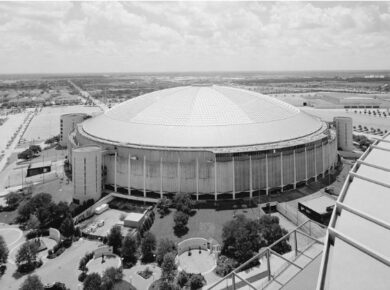On 27 May 1937 the Golden Gate Bridge was officially opened to the public. The day before vehicle traffic was allowed, 200,000 people crossed either on foot or on roller skates.
At the time of its opening in 1937, it was both the longest and the tallest suspension bridge in the world, with a main span of 1.280 m and a total height of 227m.

The final graceful suspension design was conceived by Leon Moisseiff, the engineer of the Manhattan Bridge in New York City. An expert on wind stresses on bridges, Moisseiff showed that the main cables could absorb as much as half of the wind pressures and transmit them to the bridge towers and abutments. With the suspenders properly adjusted, the bridge would be flexible enough to bend and sway with the wind. (his famous ‘deflection theory’).

Design engineer Charles Elton Ellis, working without today’s computers, devised new algebraic formulas and calculated such factors as the stresses, which each of the bridge’s hundreds of suspender ropes would bear. He produced the company’s material specifications for the towers and other bridge elements, taking into account deflections from wind and other weather.

The bridge’s two towers, the tallest ever built up until then, followed the basic design of Moisseiff’s Philadelphia-Camden Bridge, completed in 1926, which featured large steel-cell cross-members, each set within a rectangle. The Golden Gate followed this design below the roadbed, but modified it above the deck to great open rectangles without cross-members, framing the blue sky and producing a lighter look.

Photo: The Chronicle
Morrow, a relatively unknown residential architect, designed the overall shape of the bridge towers, the lighting scheme, and Art Deco elements, such as the tower decorations, streetlights, railing, and walkways. The famous International Orange color was Morrow’s personal selection

Photo: The Chronicle
The original bridge used a concrete deck. Salt carried by fog or mist reached the rebar, causing corrosion and concrete spalling. From 1982 to 1986, the original bridge deck, in 747 sections, was systematically replaced with a 40% lighter, and stronger, steel orthotropic deck panels, over 401 nights without closing the roadway completely to traffic.

Photo: The Chronicle
As far as I’m concerned the Golden Gate Bridge remains the most beautiful suspension bridge in the world. Long may she live!
About the Author:

Bruno Dursin – Managing Director at Believe in Steel. Bruno has more than 30 years of experience in promoting steel & steel solutions. His clients benefit from his extensive network within the building industry.



